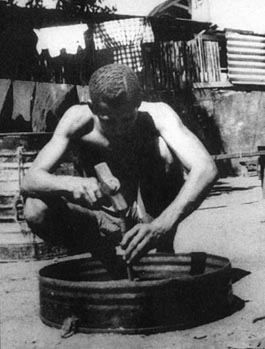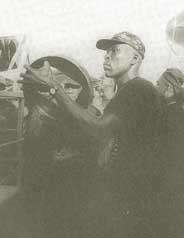Steelband - The Beginning
"Pan as an item was not invented by any person. It evolved and there are a number of people, including myself, who advanced it through certain stages of that evolution." (Elliott Mannette, October 25, 2000)
Between 1838 and 1883, the beating of skin drums was an integral part of Carnival celebrations. When a ban on all drum-beating was imposed in 1884, Carnival celebrants had to look for an alternative to the skin drum. They turned to bamboo after they discovered that dried bamboo of various diameters produced different sounds, when cut to differing lengths and struck with wooden sticks. Bands that used bamboo to produce music were called Tamboo Bamboo bands and the first report of such a band taking part in Carnival was in 1891. With the passage of time, Tamboo Bamboo bands were integrated into Carnival and flourished until the 1930s.
With an innate sense of rhythm and a burning desire to express this feeling by beating on something other than bamboo and skin drums during Carnival, some poor, Black, skillful Trinidadians turned to metal containers for music in the 1930s. Although there are varying opinions as to when the first sound from beating on metal cans was heard, there is strong evidence that such a sound occurred in 1935 when the Gonzales (Port-of-Spain) Tamboo Bamboo Band hit the road during Carnival with a bass can. As word of this innovation spread, aspiring metal can players all over Trinidad began crafting the bottoms of any metal containers (pans) that they could put their hands on, by pounding and partitioning the flat ends with hammers and steel punches to create different sounds. This art would later come to be known as tuning and the players were called panmen. By 1937, paint cans and cookie tin-cans were being played alongside Tamboo Bamboo bands during Carnival. In 1938, Victor "Toti" Wilson of the Calvary Tamboo Bamboo Band played a paint pan that had four notes tuned to the chimes of the clock at Queen's Royal College. By 1939, bands comprised of pans only began to form and were called steelbands. They initially took on names from popular American movies and the first two steelbands in the history of Trinidad were Alexander's Ragtime Band and Hellyard. In 1940, calypso music and the steelband began their long marriage when the Roaring Lion composed a calypso specifically for Alexander's Ragtime Band.
In the early stages of development, the instruments were made by pounding the tops of the metal containers outwards in a convex shape. Sound was created by beating the partitioned notes with wooden sticks. Experimentation with all types and sizes of containers accelerated as their use in making music during Carnival increased. The square cooking (sweet) oil container was also utilized, but the larger drums used by the Bermudez Company for shipping biscuits (crackers) were a favorite of the pan tuners. In 1941, the local newspaper, The Gazette, reported the use of biscuit (cracker) drums, dustbins (garbage cans), and paint cans for making music during Carnival.
 With World War II still being waged, the government placed a ban on Carnival celebrations beginning in 1942, but the steelband experiment continued at a rapid pace in the backyards of poor, Black Trinidadians. In 1943, an 8-note tenor pan was developed by Winston "Spree" Simon. When victory in Europe (VE) by the Allied Forces was attained with the surrender of Germany on May 7, 1945, the government allowed the citizens to celebrate in the streets. Thus, on VE Day (Tuesday, May 8, 1945), steelbands took advantage of the opportunity to appear on the streets officially for the first time ever. Similar celebrations were held in August 1945 after Japan surrendered to the Allied Forces on Wednesday, August 15, 1945, and victory in Japan (VJ) Day was observed. After the end of World War II, Carnival was resumed in 1946 and the steelband became an integral part of the celebration.
With World War II still being waged, the government placed a ban on Carnival celebrations beginning in 1942, but the steelband experiment continued at a rapid pace in the backyards of poor, Black Trinidadians. In 1943, an 8-note tenor pan was developed by Winston "Spree" Simon. When victory in Europe (VE) by the Allied Forces was attained with the surrender of Germany on May 7, 1945, the government allowed the citizens to celebrate in the streets. Thus, on VE Day (Tuesday, May 8, 1945), steelbands took advantage of the opportunity to appear on the streets officially for the first time ever. Similar celebrations were held in August 1945 after Japan surrendered to the Allied Forces on Wednesday, August 15, 1945, and victory in Japan (VJ) Day was observed. After the end of World War II, Carnival was resumed in 1946 and the steelband became an integral part of the celebration.
In 1946, Elliott "Ellie" Mannette (shown in the picture at right), of Woodbrook, Port-of-Spain, made the most significant change in the steelband development when he used a 55-gallon steel oil drum to craft a pan. Mannette made history when he pounded the flat surface at the top of the oil drum inward to create a concave playing surface. Compared to previous metal containers used, the oil drums provided a thicker, larger surface area for tuning and were found to retain their sound for a longer period, after they were tuned. Depending on the instrument being fabricated, the sides of the oil drums were cut to various lengths: the higher the octave, the shorter was the cut. Music was created by beating on the tuned pans with short, wooden sticks (about 8 inches long and 1/2-inch in diameter) wrapped lightly at one end with rubber salvaged from the inner tubes of bicycle tires. Rhythm was provided by the tapping of short steel rods (twigs) on the junked brake drums of motor cars; this was referred to as iron (see photo below). The sounds generated became known as steelband music and the players were referred to as panmen.
 During the 1946 Carnival, Winston "Spree" Simon served notice to the world that the pan had arrived as a musical instrument when he used his 14-note tenor pan to play "I Am A Warrior," Lord Kitchener's "Tie-Tongue Mopsy," Schubert's "Ave Maria," and the national anthem, "God Save The King," to an elite audience that included the Governor, Sir Bede Clifford. Later in 1946, Ulric Springer played his tenor-pan with two sticks and was believed to be one of the first panmen to do so. On September 15, 1946, Carlton Roach won the first soloist competition which was sponsored by Mr. Renee Phillip of Belmont, Port-of-Spain. In 1948, Ulric Springer won the pan competition at the Woodbrook Stadium playing "Over the Waves" (renamed "The Loveliest Night of the Year" in 1950) and was awarded a bicycle. By 1949, with more than 75 steelbands in existence, the Steelbands Association of Trinidad and Tobago was founded and Sydney Gollop was elected its first president.
During the 1946 Carnival, Winston "Spree" Simon served notice to the world that the pan had arrived as a musical instrument when he used his 14-note tenor pan to play "I Am A Warrior," Lord Kitchener's "Tie-Tongue Mopsy," Schubert's "Ave Maria," and the national anthem, "God Save The King," to an elite audience that included the Governor, Sir Bede Clifford. Later in 1946, Ulric Springer played his tenor-pan with two sticks and was believed to be one of the first panmen to do so. On September 15, 1946, Carlton Roach won the first soloist competition which was sponsored by Mr. Renee Phillip of Belmont, Port-of-Spain. In 1948, Ulric Springer won the pan competition at the Woodbrook Stadium playing "Over the Waves" (renamed "The Loveliest Night of the Year" in 1950) and was awarded a bicycle. By 1949, with more than 75 steelbands in existence, the Steelbands Association of Trinidad and Tobago was founded and Sydney Gollop was elected its first president.